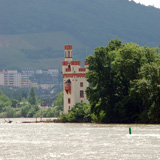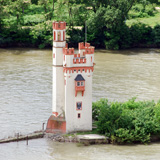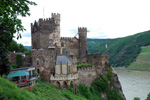History
The Mäuseturm was probably built in the 13th century by the Archbishop of Mainz as a watchtower and toll station. It was enlarged in the 14th century and rebuilt in the Neo-Gothic style in the 19th century, where it served as a lighthouse until 1974.

It is thought a Roman tower originally stood on this small island in the River Rhine until Archbishop Hatto II of Mainz incorporated it into his place of rest in the 10th century, which he called Hattenburg.
In 1258, the tower underwent alterations and was added to the toll station of nearby Burg Ehrenfels on the banks of the River Rhine as an official customs collection tower. It was under constant embattlement from 1631-1640 and burned to the ground by the French in 1689.
The Mäuseturm remained in ruins until 1855, when it was restored by King Friedrich Wilhelm IV in the Neo-Gothic style and used as a Prussian signal tower.
Although it is said that the name Mäuseturm means Mouse Tower, based on the legend linked to the castle of Bishop Hatto being trapped and eaten by mice in the castle, the name Mauseturm is derived from the word maut or toll.
Castle Highlights
The Mäuseturm is a four-story tower with four battlement-adorned corner turrets. A pentagonal staircase tower is on the forward-positioned ice apron at the front of the building. The tower is 6 meters wide by 6 meters long.
The Mäuseturm is closed to the public for visiting but can be visited by special appointment. The way to book the special appointment is not clear.
Nearby castles on the Rhine River are open to the public and are an easy drive from the Mäuseturm, including Burg Rheinstein, Burg Reichenstein, and Burg Sooneck.
There is a legend associated with the Mäuseturm.





